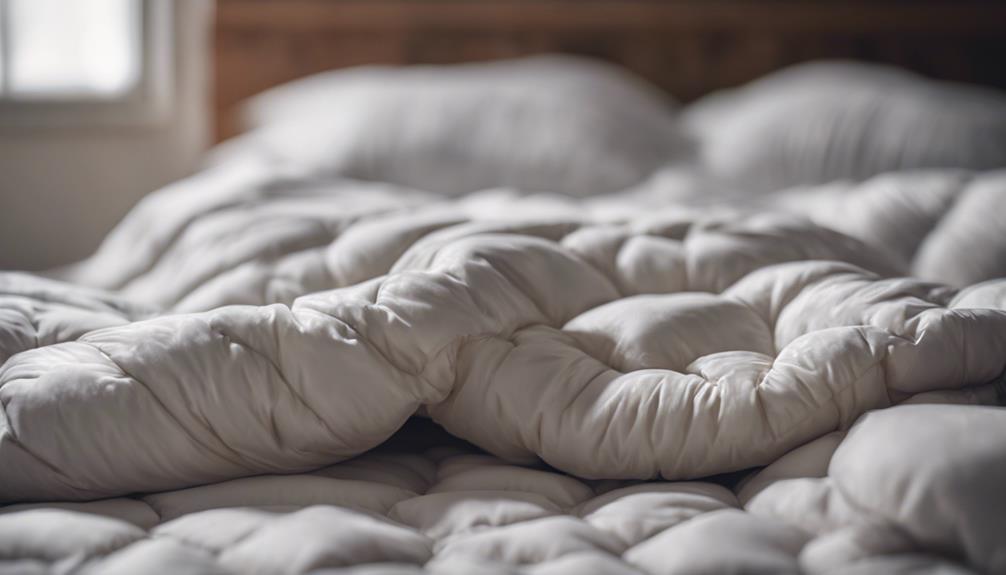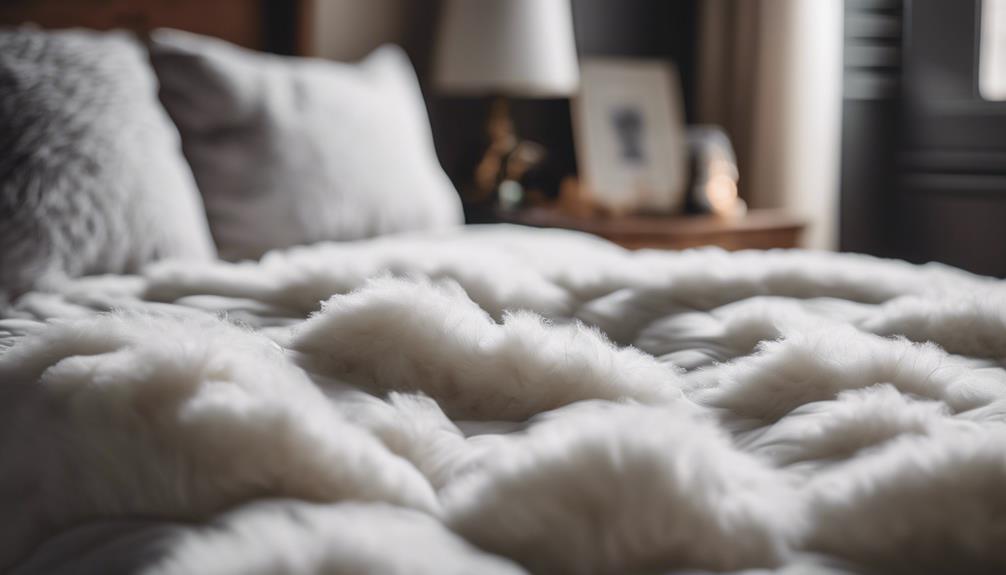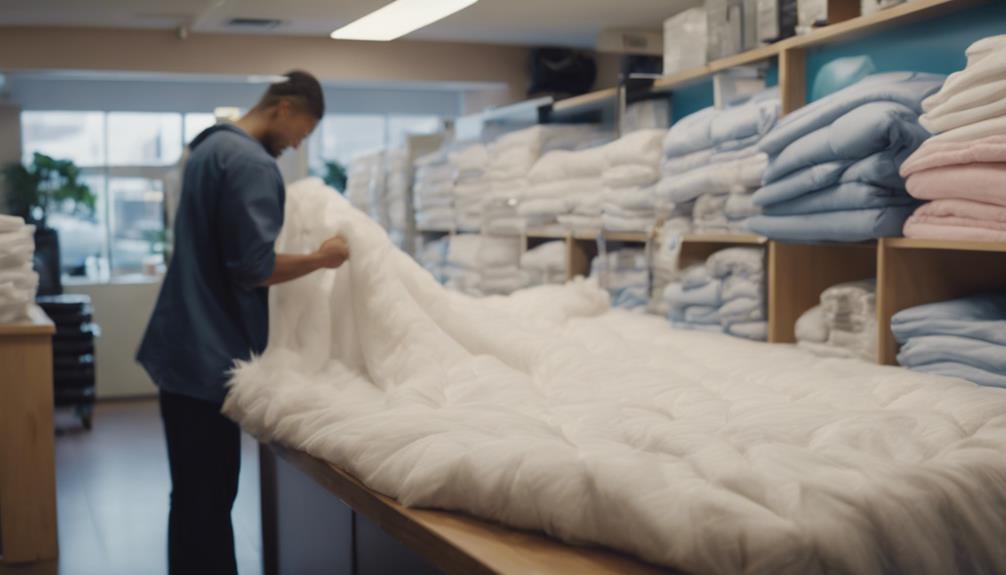When you purchase a new down comforter, begin by shaking it out on the bed to fluff it up. Attach a duvet cover with loops, allow it to fully loft up after shipping, and gently pat, shake, and hang it. Use a dryer on low heat with dryer balls for extra fluff. Air it out in a cool place and restore its shape by pulling the edges. Select an appropriate duvet cover for protection and wash it separately with a mild detergent. For a cozy comforter experience, shake it out regularly, make use of duvet loops, and let it fluff up naturally. Explore more ways to care for your comforter to keep it in top condition.
Key Takeaways
- Shake out the comforter to allow for loftiness and fluffiness.
- Use duvet loops to secure a duvet cover for a snug fit.
- Air out the comforter in a ventilated area to maintain freshness.
- Avoid frequent washing to preserve the down's loftiness.
- Enjoy the cozy comfort by preventing shifting with a secure cover.
Preparing Your New Down Comforter
To get your new down comforter ready for use, we suggest shaking it out on the bed to allow the down to fluff up. This simple step helps evenly distribute the down, ensuring maximum fluffiness and warmth. Once shaken out, consider using duvet loops to secure a duvet cover for added protection. These loops can help keep the comforter in place inside the cover, preventing it from shifting around.
When your New Down Comforter arrives, it may have been compressed during shipping. Give it some time to regain its loftiness before using it for the best sleeping experience. Avoid washing the new down comforter frequently, as this can affect its quality and lifespan. Instead, opt for regular airing out to keep it fresh and fluffy.
Fluffing Techniques for Down Comforters

When it comes to down comforters, knowing how to fluff them properly is key to maintaining their loftiness and comfort.
Gentle patting, shaking, and hanging in a cool, ventilated area can help break up clumps and restore fluffiness.
Using a dryer on low heat with dryer balls can also guarantee the down fill is evenly distributed and fluffy.
Fluffing Down Comforter
We find that gently patting and shaking the down comforter helps break up clumps and restore its fluffiness. Sometimes, if the comforter is particularly flat or lumpy, using dryer balls in the dryer on a low-temperature setting can help distribute the down evenly and fluff it up. Here is a table to summarize some fluffing techniques:
| Fluffing Techniques | Description | Benefits |
|---|---|---|
| Gently Patting | Lightly press down and lift up | Breaks up clumps |
| Shaking | Vigorously shake the comforter | Restores fluffiness |
| Using Dryer Balls | Place dryer balls in the dryer | Even distribution of down |
Maintaining Fluffiness
Maintaining fluffiness in down comforters involves several steps. One key step is gently patting and shaking the comforter to break up clumps and restore its loft and softness. Another important aspect is airing out the comforter in a cool, ventilated place for 2-3 hours to help maintain loft. Additionally, using a low-temperature dryer setting with dryer balls can evenly distribute down and fluff up the comforter. To restore the shape, gently pull the edges and flip the comforter to guarantee even fluffiness. Repeat these fluffing techniques as needed until the comforter regains its full loft and softness. By following these methods, you can keep your down comforter fluffy and cozy for a long time.
Pro Tips for Fluffing
Want to know the best pro tips for fluffing your new down comforter effectively?
To start, gently pat and shake the comforter to break up clumps and restore fluffiness. Then, hang it in a cool, ventilated area for 2-3 hours to air it out.
If you prefer a quicker method, use a dryer on a low-temperature setting with dryer balls to evenly distribute down and fluff up the comforter.
Don't forget to restore the shape by gently pulling the edges and flipping the comforter regularly for even fluffiness.
Repeat these steps as needed until your comforter regains its full loftiness. These techniques will keep your down comforter cozy and fluffy for a long time.
Choosing the Right Duvet Cover
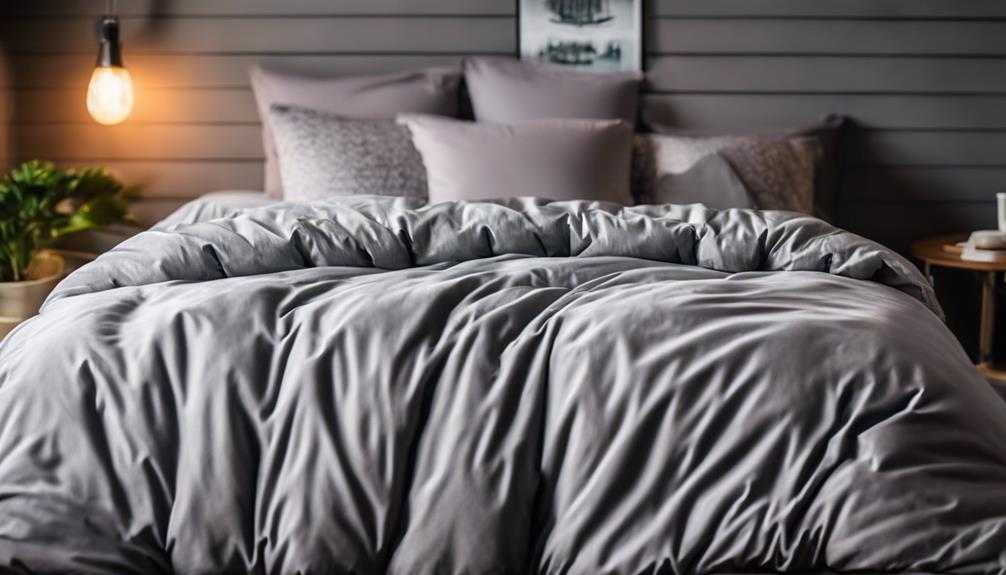
When selecting a duvet cover for your new down comforter, it's essential to take into account the fabric type, thread count, and weave to ensure compatibility and comfort. Here are some key points to keep in mind:
- Look for duvet covers with corner ties or loops: These features help secure the comforter in place, preventing it from shifting inside the cover and ensuring a more restful night's sleep.
- Choose a duvet cover size that matches the dimensions of your down comforter: Opting for the right size will provide a snug fit, preventing the comforter from bunching up or sliding around inside the cover.
- Opt for duvet covers with zipper closures or buttons: Easy removal options make washing and maintaining the cover a breeze, promoting the cleanliness and longevity of your down comforter.
- Select a duvet cover color or pattern that complements your bedroom decor: Enhance the aesthetic appeal of your bedding ensemble by choosing a color or pattern that ties the room together and reflects your personal style.
Washing and Maintaining the Cover
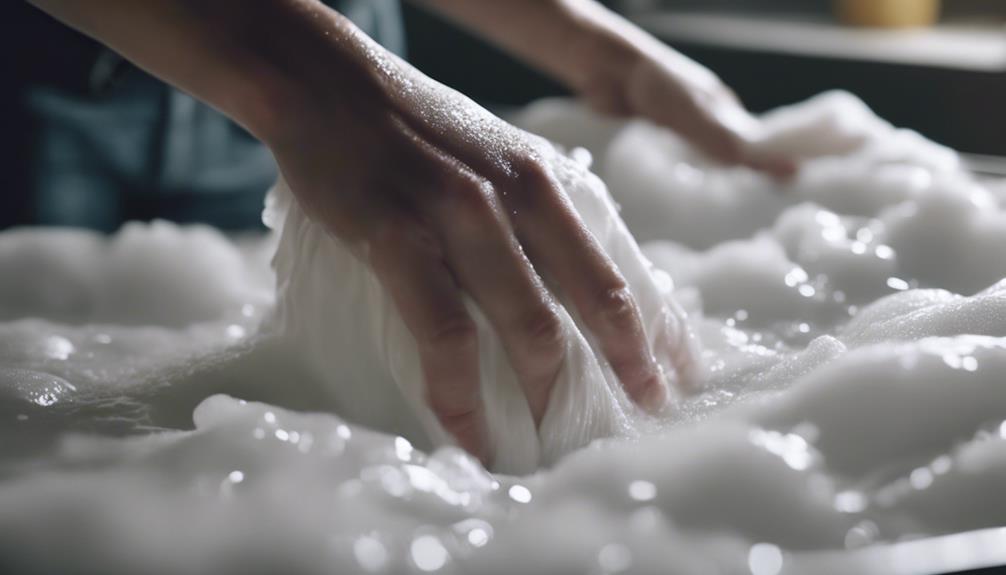
When it comes to washing and maintaining your duvet cover, it's important to keep a few key points in mind.
First, always wash the cover separately to prevent damage and guarantee even cleaning.
Next, opt for a mild detergent and cold water to avoid any potential shrinking or damage to the fabric.
Lastly, avoid using bleach or fabric softeners, as they can harm the fibers of the cover and affect its quality over time.
Cover Washing Tips
When washing and maintaining the cover of a new down comforter, it's important to use a gentle detergent specifically designed for down products to guarantee proper care and longevity. Here are some cover washing tips to keep in mind:
- Avoid harsh chemicals: Skip the bleach and fabric softeners to prevent damage to the fabric and filling.
- Follow manufacturer's instructions: Stick to the care guidelines provided to make sure the cover stays in top condition.
- Use gentle cycles: Wash in cool or warm water on a gentle cycle to preserve the cover's quality and prevent shrinkage.
- Dry with care: Air dry or tumble dry on low heat to avoid damaging the cover and impacting its lifespan.
Maintaining Cover Quality
To maintain the quality of your duvet cover, it's essential to wash it separately from the down comforter using a gentle cycle and mild detergent. This practice helps guarantee that any damage that could occur from more rigorous washing methods.
Avoid using bleach or fabric softeners as they can harm the fabric. Always refer to the care label on the duvet cover for specific washing instructions to make sure you're following the manufacturer's recommendations.
When not in use, store the duvet cover in a breathable bag to shield it from dust and dirt, prolonging its lifespan. By taking these simple steps, you can keep your duvet cover looking fresh and in top condition for a long time.
Properly Air Out Your Comforter
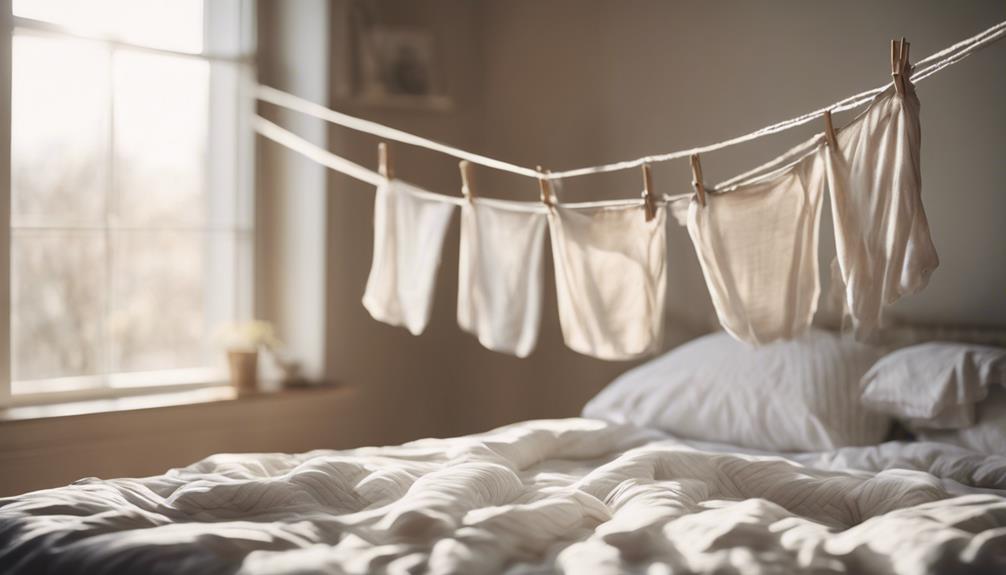
Let's air out our new down comforter in a well-ventilated area for 2-3 hours to eliminate any packaging odors. Avoid doing this in damp places to prevent moisture absorption. Hanging the comforter aids in fluffing up the down clusters and evenly redistributing the fill. By airing out the comforter, it can regain its natural loft and fluffiness that may have been compressed during shipping. This can enhance the overall comfort and performance of the comforter.
- Airing out the comforter in a well-ventilated area helps eliminate any unwanted packaging odors, making your sleep experience more pleasant.
- Avoiding damp or humid conditions prevents moisture from being absorbed into the comforter, maintaining its quality and prolonging its lifespan.
- Hanging the comforter allows the down clusters to fluff up and evenly distribute the fill, ensuring a cozy and comfortable night's sleep.
- Properly airing out the comforter not only removes odors but also helps it regain its natural loft, providing you with a luxurious and fluffy bedding experience.
Consider Professional Cleaning

Considering professional cleaning for your new down comforter can help maintain its quality and longevity. Specialized cleaning services offer the expertise needed to properly care for the delicate down filling in your comforter. Professional cleaners are equipped to remove dirt, stains, and odors effectively, guaranteeing a thorough cleaning process.
By entrusting your down comforter to experts, you can prevent potential damage and make sure that it's cleaned meticulously. Regular professional cleaning sessions not only keep your comforter fresh but also help it stay fluffy and cozy for a longer period. This maintenance routine can extend the lifespan of your down comforter, allowing you to enjoy its warmth and comfort for years to come.
Investing in professional cleaning is a proactive way to preserve the quality of your new down comforter and ensure that it remains a luxurious addition to your bedding collection.
Maintaining Loft and Freshness

When looking to maintain the loft and freshness of your new down comforter, it's important to regularly air it out and use a duvet cover for protection. Here are some tips to help you keep your comforter in top condition:
- Air it out: By allowing your comforter to breathe, you prevent any musty odors from developing and help maintain its freshness.
- Use a duvet cover: Protect your comforter from dirt, stains, and spills by using a duvet cover. This will also make cleaning easier and extend the life of your comforter.
- Avoid frequent washing: Washing your down comforter too often can reduce its loftiness. Instead, spot clean when necessary and opt for professional cleaning when it's time for a thorough wash.
- Shake and fluff daily: To maintain the loft of your comforter, give it a good shake and fluff every day. This redistributes the fill inside, keeping it fluffy and cozy.
Enjoying Your Cozy Down Comforter

After shaking out your new down comforter to allow the down to regain its loftiness, you can enhance your cozy experience by utilizing the duvet loops for a snug fit with the cover.
These loops are designed to help secure the comforter in place within the duvet cover, preventing any shifting or bunching up of the down.
Once you've attached the cover securely, give your down comforter some time to fluff up naturally and fully regain its plushness.
Frequently Asked Questions
What to Do When You Get a New Down Comforter?
When we get a new down comforter, we should shake it out on the bed to let the down fluff up. If it's got duvet loops, we can secure the cover for a snug fit.
Daily shaking helps redistribute the fill and keep it lofty. After a few hours on the bed, the down should regain its fluffiness. If it stays flat after two weeks, we might want to think about getting a new one for better loftiness.
Should I Wash a New Down Comforter Before Using It?
We usually don't wash a new down comforter right away unless it's noticeably dirty or has a strong smell. Down comforters are generally clean and ready to use straight from the package.
Washing it prematurely can harm the down's natural oils and fluffiness. To keep your comforter in top shape, follow the manufacturer's care instructions. If you do decide to wash it, use a gentle detergent and a large washer for best results.
How to Make a New Down Comforter Fluffy?
To make a new down comforter fluffy, let it rest on the bed for a few hours to expand. Shake it daily to redistribute the fill and enhance fluffiness. Some comforters may take up to two weeks to reach their full loft.
If the loftiness doesn't improve, consider replacing it. Regular care like shaking and airing out can help maintain the fluffiness.
Can I Put My Down Comforter in the Dryer?
Yes, we can put a down comforter in the dryer. Using a low-heat setting helps fluff up the down fill. Adding dryer balls breaks clumps and guarantees even distribution. Avoid high heat to prevent damage.
The dryer restores loftiness after compression. Regular drying maintains fluffiness and prolongs lifespan. Remember, a dryer can be a down comforter's best friend!
Will Fluffing up a Down Comforter Affect What I Can Do With It?
Fluffing up a down comforter can make a big difference in its overall appearance and comfort. Spending some down comforter fluff time can help redistribute the feathers and ensure the comforter maintains its fluffiness, which will make it more enjoyable to use and give it a longer lifespan.
Conclusion
To sum up, taking care of your new down comforter is like tending to a delicate garden – with the right techniques and attention, it will bloom beautifully for years to come.
Remember to fluff it regularly, choose a quality duvet cover, wash and maintain it properly, and air it out to maintain its freshness.
By following these simple steps, you can enjoy the cozy warmth and comfort of your down comforter for a long time.



